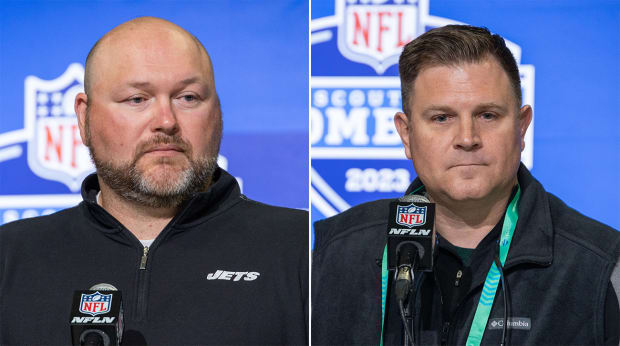Let’s get this out of the way first—the Packers are winners here. Aaron Rodgers, by his own words, was never playing for Green Bay again, with his stated plan to retire only usurped by his anger over the team’s maneuvering while he was considering his options.
In the end, they actually come out of this better than they would have, had Rodgers retired.
The Packers move up two spots in the first round and get the 42nd pick this year, and a second-rounder next year that becomes a first-rounder if Rodgers plays 65% of the Jets’ snaps next year (so he basically just has to stay healthy for it to be a one), with the only giveback being a fifth-rounder getting moved down 37 spots, and into the sixth round.
Fifteen years ago, the Jets got Brett Favre, a year younger at the time, for a conditional third-rounder that became a third-rounder when Favre hit a play-time trigger. Safe to say, the Packers did better this time around.
And yet, given where they were, there really wasn’t any way the Jets could possibly fall short of this conclusion. They’d already symbolically sent Zach Wilson back to the bullpen. They’d let the offseason pass with other veteran options at the position to whom their coaches had connections signing elsewhere (Jimmy Garoppolo’s now a Raider, Derek Carr’s now a Saint). They’d hired Nathaniel Hackett and signed Allen Lazard.
They basically assembled the car. It would’ve been worthless without the engine.

Trevor Ruszkowski/USA TODAY Sports (Douglas); Trevor Ruszkowski/USA TODAY Sports (Gutekunst)
That, and the structure of Rodgers’s contract, is why the Packers had plenty of leverage to work with when negotiating with Jets GM Joe Douglas. Green Bay, of course, had motivation to do a deal, too—to complete the transition to Jordan Love, and to turn the page and get value back for one of the greatest players in franchise’s history. But failing to make a deal happen wouldn’t have had nearly the consequences for Brian Gutekunst and Matt LaFleur that it would for Douglas and Robert Saleh.
That was really the landscape all along here, and that’s why it was challenging, at times, for the sides to work through it and find a fair agreement.
Orr: In Wake of Aaron Rodgers Trade, Jets Fans Shouldn’t Feel As Tortured As They Claim to Be
As for the Jets, here’s the upside: If Rodgers is still Rodgers, it won’t matter what they paid.
Which is what this trade really boils down to for New York.
A little more on the nuts and bolts of how this came down.
• Gutekunst and Douglas spoke before the owners meetings in late March, and the framework of the deal started to come together. Around then, the Packers came off their initial ask to get the 13th pick clean (without an associated pick swap, with the assumption from that point being the Jets’ 2023 second-round pick (No. 42) or the one they acquired from Cleveland in the Elijah Moore trade (No. 42) would be part of the deal.
• Coming out of the owners meetings, Douglas and Gutekunst had come up with a number of solutions. The Packers even sent the Jets a handful of acceptable trades. But at that point, concerns from above the GMs prevented the deal from being done. The Jets wanted conditions to protect themselves from being this year’s version of the Broncos (who wound up surrendering this year’s fifth pick in the Russell Wilson trade), and from Rodgers playing a single year and retiring. The Packers wanted a hard first-round pick as part of the deal.
• To break the stalemate, the GMs reconvened on Friday to try to bridge the gap, with the Packers telling the Jets that the deal would have to have a day of breathing room, so they could adjust Rodgers’s contract to make it work from a cap standpoint. That gave the teams a realistic deadline of Tuesday or Wednesday to get a deal done.
• The final deal has the 42nd pick fronting it, as was expected. The Jets also agreed to dropping two spots in this year’s first round in a pick swap, from 13 to 15, with the Packers exchanging a sixth-rounder (No. 207) for a fifth-rounder (No. 170) on the back end. And as for breaking the gridlock on the 2024 pick, the Packers essentially gave the Jets protection against a Rodgers injury, but not a downturn in performance—accepting a second-rounder next year, that becomes a first-rounder if Rodgers plays 65% of the snaps.
And, in the end, the Jets also didn’t get protection against Rodgers deciding to retire after the 2023 season—one earlier proposal had the Jets giving the Packers a ’24 first-rounder, and the Packers giving the Jets a ’25 second-rounder back if Rodgers didn’t play for New York in ’24.
That, of course, would be another win for the Packers.
But guess what? If this plays out like Tom Brady’s second act in Tampa Bay , or Peyton Manning’s second act in Denver, or even like Favre’s run in Minnesota did, none of that will matter for the Jets. And if it doesn’t, well, there’ll be new people in charge anyway.
Which is just another reason why the Jets had to get this done. And why, in the end, Douglas and Saleh deserve plenty of credit for sticking with it and getting over the goal line.







